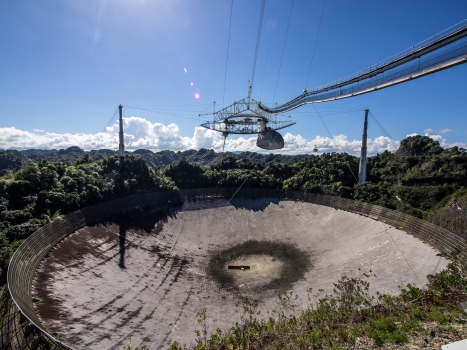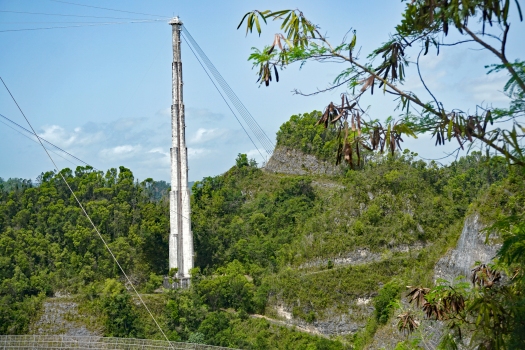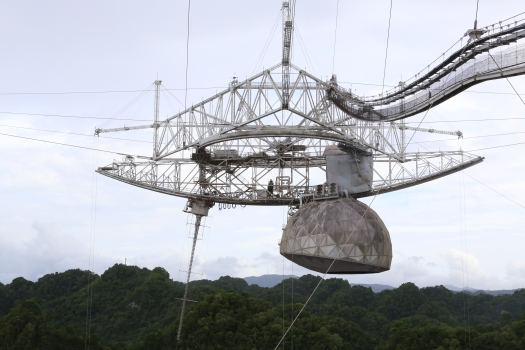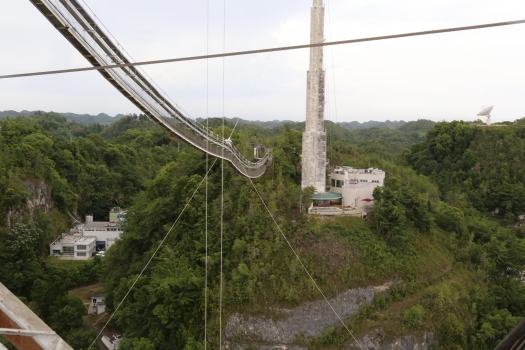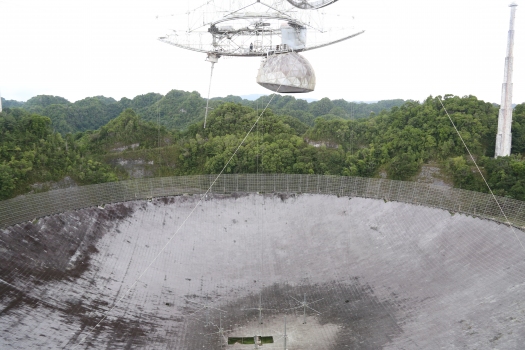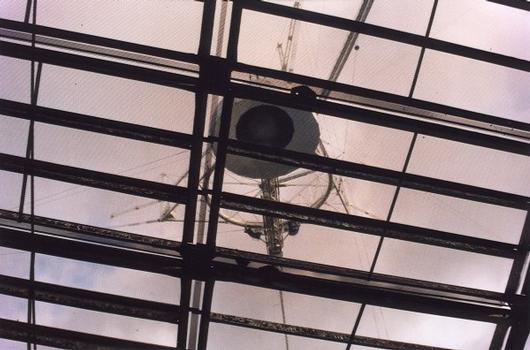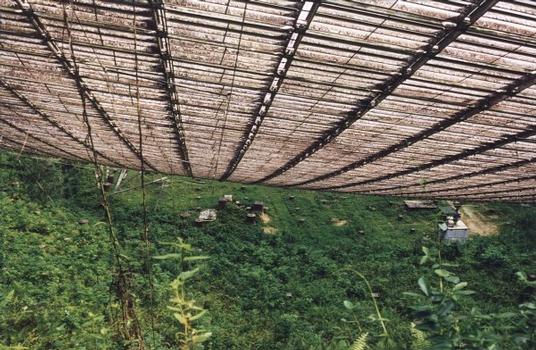General Information
| Other name(s): | Arecibo Observatory |
|---|---|
| Beginning of works: | 1960 |
| Completion: | 1 November 1963 |
| Status: | collapsed (1 December 2020) |
Project Type
| Function / usage: |
Radio telescope |
|---|---|
| Structure: |
platform: Cable-suspended structure dish: Cable net |
Location
| Location: |
Arecibo, Puerto Rico, USA |
|---|---|
| Coordinates: | 18° 20' 38.97" N 66° 45' 10.07" W |
Technical Information
Dimensions
| dish | diameter | 304.8 m |
| depth | 51.4 m | |
| platform | weight | 820 t |
| height to platform | 150 m | |
| pylon 1 | height | 111 m |
| pylon 2 | height | 81 m |
| pylon 3 | height | 81 m |
Materials
| cables |
steel wire
|
|---|---|
| pylons |
reinforced concrete
|
| platform |
steel
|
| sheeting |
aluminum
|
Chronology
| 10 August 2020 | One of the cables from which the receiver array structure is suspended snaps. The falling cable tears a roughly 30 meter long gap into the reflector dish below. |
|---|---|
| 6 November 2020 | A second suspension cable snaps causing more damage on the reflector but also to other cables. The overall structural stability of the structure is threatened and thus closed to personnel. |
| 19 November 2020 | After the risk of collapse steadily increases as individual strands of the suspension cables continue failing daily, the NSF decides to decomission and demolish the structure. |
| 1 December 2020, 07:53 | The receiver array collapses into the dish after another of the suspension cables snaps entirely. As the other suspension cables are no longer sufficient to carry the dead load of the receiver array, these also snap resulting in the fall of the entire receiver structure into the dish below. Probably due to the asymmetric and impact loading from this collapse, the top of all three concrete pylons are also sheared off. |
Notes
The largest single-dish radio telescope in the world. It came into operation in 1963 and is operated by Cornell University for the National Science Foundation. Occupying a large karst sinkhole in the hills south of Arecibo in Puerto Rico, its area of almost 9 hectares is greater than that of all other such instruments in the world combined. The surface of Arecibo's 305-meter (1,000-foot) fixed, spherical dish is made from almost 40,000 perforated aluminum panels, each measuring 1 meter by 2 meters (3 feet by 6 feet), supported by a network of steel cables strung across the underlying depression. Suspended 150 meters (450 feet) above the reflector is a 900-ton platform which houses the receiving equipment. Although the telescope is not steerable, some directionality is obtained by moving the feed antenna (upgraded in 1996). The immense size and accurate configuration of the dish allows extremely faint signals to be detected. For this reason, it has been used extensively in SETI investigations and in the first attempt at CETI (see Arecibo Message). It also featured in the film Contact. The giant radio telescope dish at the Arecibo Observatory in Puerto Rico is nestled in a natural sinkhole. The Search for Extraterrestrial Intelligence (SETI) has been using the telescope to search for radio signals from space since 1992. The Arecibo radio telescope is located in Puerto Rico about 10 km south of the town of Arecibo, which is located on the north coast of the island. It is operated by Cornell University under cooperative agreement with the National Science Foundation. Arecibo is one of the most famous such telescopes in the world, distinguished by its enormous size; the main collecting dish is 305 meters in diameter, constructed inside the depression left by a karst sinkhole. It is the largest curved focusing dish on Earth, giving it the largest photon-gathering capacity. Arecibo's dish surface is made of 38,778 perforated aluminum panels, each measuring about 3 feet by 6 feet, supported by a mesh of steel cables. It is a spherical reflector (as opposed to a parabolic reflector). This form is due to the method used to aim the telescope; Arecibo's dish is fixed in place, but the receiver at its focal point is repositioned to intercept signals reflected from different directions by the spherical dish surface. The receiver is located on a 900-ton platform which is suspended 450 feet in the air above the dish by 18 cables running from three reinforced concrete towers, one of which is 365 feet high and the other two of which are 265 feet high (the tops of the three towers are at the same elevation). The platform has a 93 meter long rotating bow-shaped track called the azimuth arm on which receiving antennae, secondary and tertiary reflectors are mounted. This allows the telescope to observe any region of the sky within a forty degree cone of visibility about the local zenith (between -1 and 38 degrees of declination). Puerto Rico's location near the equator allows Arecibo to view all of the planets in the solar system. The construction of Arecibo was initiated by Professor William E. Gordon of Cornell University, who originally intended to use it for the study of Earth's ionosphere. Originally, a fixed parabolic reflector was envisioned, pointing in a fixed direction with a 500 foot tower to hold equipment at the focus. This design would have had a very limited use for other potential areas of research, such as planetology and radio astronomy, which require the ability to point at different positions in the sky and to track those positions for an extended period as Earth rotates. Ward Low of ARPA pointed out this flaw, and put Gordon in touch with the Air Force Cambridge Research Laboratory (AFCRL) in Boston, Massachusetts where a group headed by Phil Blacksmith was working on spherical reflectors and another group was studying the propagation of radio waves in and through the upper atmosphere. Cornell University proposed the project to ARPA in the summer of 1958 and a contract was signed between the AFCRL and the University in November of 1959. Construction began in the summer of 1960, with the official opening taking place on November 1, 1963. Arecibo has been instrumental in many significant scientific discoveries. On April 7 1964, shortly after its inauguration, Gordon H. Pettengill's team used Arecibo to determine that the rotation rate of Mercury was not 88 days, as previously thought, but only 59 days. Arecibo also had military intelligence uses, for example locating Soviet radar installations by detecting their signals bouncing back off of the Moon. Arecibo has undergone several significant upgrades over its lifespan.
Excerpt from Wikipedia
The Arecibo Telescope was a 305 m (1,000 ft) spherical reflector radio telescope built into a natural sinkhole at the Arecibo Observatory located near Arecibo, Puerto Rico. A cable-mount steerable receiver was mounted 150 m (492 ft) above the dish, and several radar transmitters for emitting signals. Completed in November 1963, the Arecibo Telescope was the world's largest single-aperture telescope for 53 years, until it was surpassed in July 2016 by the Five-hundred-meter Aperture Spherical Telescope (FAST) in Guizhou, China.
The Arecibo Telescope was primarily used for research in radio astronomy, atmospheric science, and radar astronomy, as well as for programs that search for extraterrestrial intelligence (SETI). Scientists wanting to use the observatory submitted proposals that were evaluated by independent scientific referees. NASA also used the telescope for near-Earth object detection programs. The observatory, funded primarily by the National Science Foundation (NSF) with partial support from NASA, was managed by Cornell University from its completion in 1963 until 2011, after which it was transferred to a partnership led by SRI International. In 2018, a consortium led by the University of Central Florida assumed operation of the facility.
The telescope's unique and futuristic design led to several appearances in film, gaming and television productions, such as for the climactic fight scene in the James Bond film GoldenEye (1995). It has been listed on the US National Register of Historic Places since 2008. The center was named an IEEE Milestone in 2001.
Since 2006, the NSF has reduced its funding commitment to the observatory, leading academics to push for additional funding support to continue its programs. The telescope was damaged by Hurricane Maria in 2017 and was affected by earthquakes in 2019 and 2020. Two cable breaks, one in August 2020 and a second in November 2020, threatened the structural integrity of the support structure for the suspended platform and damaged the dish. Due to uncertainty over the remaining strength of the other cables supporting the suspended structure, and the risk of collapse owing to further failures making repairs dangerous, the NSF announced on November 19, 2020, that it would decommission and dismantle the telescope, with the radio telescope and LIDAR facility remaining operational. Before it could be decommissioned, several of the remaining support cables suffered a critical failure and the support structure, antenna, and dome assembly all fell into the dish at 7:55 a.m. local time on December 1, 2020.
General information
The telescope's main collecting dish had the shape of a spherical cap 1,000 feet (305 m) in diameter with an 869-foot (265 m) radius of curvature, and was constructed inside a karst sinkhole. The dish surface was made of 38,778 perforated aluminum panels, each about 3 by 7 feet (1 by 2 m), supported by a mesh of steel cables. The ground beneath supported shade-tolerant vegetation.
The telescope had three radar transmitters, with effective isotropic radiated powers (EIRPs) of 22 TW (continuous) at 2380 MHz, 3.2 TW (pulse peak) at 430 MHz, and 200 MW at 47 MHz, as well as an ionospheric modification facility operating at 5.1 and 8.175 MHz.
The dish remained stationary, while receivers and transmitters were moved to the proper focal point of the telescope to aim at the desired target. As a spherical mirror, the reflector's focus is along a line rather than at one point. As a result, complex line feeds were implemented to carry out observations, with each line feed covering a narrow frequency band measuring 10–45 MHz. A limited number of line feeds could be used at any one time, limiting the telescope's flexibility.
The receiver was on an 820-tonne (900-short-ton) platform suspended 150 m (492 ft) above the dish by 18 cables running from three reinforced concrete towers, one 111 m (365 ft) high and the other two 81 m (265 ft) high, placing their tops at the same elevation. The platform had a rotating, bow-shaped track 93 m (305 ft) long, called the azimuth arm, carrying the receiving antennas and secondary and tertiary reflectors. This allowed the telescope to observe any region of the sky in a forty-degree cone of visibility about the local zenith (between −1 and 38 degrees of declination). Puerto Rico's location near the Northern Tropic allowed the Arecibo telescope to view the planets in the Solar System over the northern half of their orbit. The round trip light time to objects beyond Saturn is longer than the 2.6-hour time that the telescope could track a celestial position, preventing radar observations of more distant objects.
History
Design and construction
A detailed view of the beam-steering mechanism. The triangular platform at the top was fixed, and the azimuth arm rotated beneath it. To the right was the Gregorian sub-reflector, and to the left was the remains of the 96-foot-long (29 m) line feed tuned to 430 MHz (destroyed by Hurricane Maria). Also to the right was the catwalk and part of the rectangular waveguide that brought the 2.5 MW 430 MHz radar transmitter's signal up to the focal region.
The origins of the observatory trace to late 1950s efforts to develop anti-ballistic missile (ABM) defenses as part of the newly formed ARPA's ABM umbrella-effort, Project Defender. Even at this early stage it was clear that the use of radar decoys would be a serious problem at the long ranges needed to successfully attack a warhead, ranges on the order of 1,600 km (1,000 mi).
Among the many Defender projects were several studies based on the concept that a re-entering nuclear warhead would cause unique physical signatures while still in the upper atmosphere. It was known that hot, high-speed objects caused ionization of the atmosphere that reflects radar waves, and it appeared that a warhead's signature would be different enough from decoys that a detector could pick out the warhead directly, or alternately, provide added information that would allow operators to focus a conventional tracking radar on the single return from the warhead.
Although the concept appeared to offer a solution to the tracking problem, there was almost no information on either the physics of re-entry or a strong understanding of the normal composition of the upper layers of the ionosphere. ARPA began to address both simultaneously. To better understand the radar returns from a warhead, several radars were built on Kwajalein Atoll, while Arecibo started with the dual purpose of understanding the ionosphere's F-layer while also producing a general-purpose scientific radio observatory.
The observatory was built between mid-1960 and November 1963. William E. Gordon of Cornell University oversaw its design for study of the Earth's ionosphere. He was attracted to the sinkholes in the karst regions of Puerto Rico that offered perfect cavities for a very large dish. Originally, a fixed parabolic reflector was envisioned, pointing in a fixed direction with a 150 m (492 ft) tower to hold equipment at the focus. This design would have limited its use in other research areas, such as radar astronomy, radio astronomy and atmospheric science, which require the ability to point at different positions in the sky and track those positions for an extended time as the Earth rotates.
Ward Low of the Advanced Research Projects Agency (ARPA) pointed out this flaw and put Gordon in touch with the Air Force Cambridge Research Laboratory (AFCRL) in Boston, Massachusetts, where one group headed by Phil Blacksmith was working on spherical reflectors and another group was studying the propagation of radio waves in and through the upper atmosphere. Cornell University proposed the project to ARPA in mid-1958 and a contract was signed between the AFCRL and the University in November 1959. Cornell University and Zachary Sears published a request for proposals (RFP) asking for a design to support a feed moving along a spherical surface 133 metres (435 ft) above the stationary reflector. The RFP suggested a tripod or a tower in the center to support the feed. On the day the project for the design and construction of the antenna was announced at Cornell University, Gordon had also envisioned a 133 m (435 ft) tower centered in the 305 m (1,000 ft) reflector to support the feed.
George Doundoulakis, who directed research at General Bronze Corporation in Garden City, New York, along with Zachary Sears, who directed Internal Design at Digital B & E Corporation, New York, received the RFP from Cornell University for the antenna design and studied the idea of suspending the feed]] with his brother, Helias Doundoulakis, a civil engineer. George Doundoulakis identified the problem that a tower or tripod would have presented around the center, (the most important area of the reflector), and devised a better design by suspending the feed. He presented his proposal to Cornell University for a doughnut or torus-type truss suspended by four cables from four towers above the reflector, having along its edge a rail track for the azimuthal truss positioning. This second truss, in the form of an arc, or arch, was to be suspended below, which would rotate on the rails through 360 degrees. The arc also had rails on which the unit supporting the feed would move for the feed's elevational positioning. A counterweight would move symmetrically opposite to the feed for stability and, if a hurricane struck, the whole feed could be raised and lowered. Helias Doundoulakis designed the cable suspension system which was finally adopted. The present configuration is substantially the same as in the original drawings by George and Helias Doundoulakis, although with three towers, instead of the four drawn in the patent granted to Helias Doundoulakis by the U.S. Patent office. The idea of a spherical reflecting mirror with a steerable secondary has since been used in optical telescopes, in particular, the Hobby–Eberly Telescope
Construction began in mid-1960, with the official opening on November 1, 1963.
Upgrades
Since then, the telescope was upgraded several times. Initially, when the maximum expected operating frequency was about 500 MHz, the surface consisted of half-inch galvanized wire mesh laid directly on the support cables. In 1973, a high-precision surface consisting of 38,000 individually adjustable aluminum panels replaced the old wire mesh, and the highest usable frequency rose to about 5000 MHz. A Gregorian reflector system was installed in 1997, incorporating secondary and tertiary reflectors to focus radio waves at one point. This allowed installing a suite of receivers, covering the full 1–10 GHz range, that could be easily moved to the focal point, giving Arecibo more flexibility. A metal mesh screen was also installed around the perimeter to block the ground's thermal radiation from reaching the feed antennas. Finally, a more powerful 2400 MHz transmitter was added.
Funding reductions
The Astronomical Sciences and Atmospheric Sciences divisions of the NSF had financially supported Arecibo since its completion in the 1970s, with incremental support by NASA, for operating the planetary radar. Between 2001 and 2006, NASA decreased, then eliminated, its support of the planetary radar.
A November 2006 report by the Astronomical Sciences division recommended substantially decreased astronomy funding for the Arecibo Observatory, from US$10.5 million in 2007 to US$4.0 million in 2011. The report further stated that if other sources of funding could not be found, closure of the Observatory was recommended.
Academics and researchers responded by organizing to protect and advocate for the observatory. They established the Arecibo Science Advocacy Partnership (ASAP) in 2008, to advance the scientific excellence of Arecibo Observatory research and to publicize its accomplishments in astronomy, aeronomy and planetary radar as to seek additional funding support for the observatory. An additional US$3 million in bonds were secured from the government of Puerto Rico. Academics, media and influential politicians pressured the United States Congress on the importance of the work of the observatory. led to additional US$3.1 million in funding to support Arecibo in the American Recovery and Reinvestment Act of 2009. This was used for basic maintenance and for a second, much smaller, antenna to be used for very long baseline interferometry, new Klystron amplifiers for the planetary radar system and student training.
Arecibo's budget from NSF continued to wane in the following years. Starting in FY2010, NASA restored its historical support by contributing $2.0 million per year for planetary science, particularly the study of near-Earth objects, at Arecibo. NASA implemented this funding through its Near Earth Object Observations program. NASA increased its support to $3.5 million per year in 2012.
In 2011, NSF removed Cornell University, which had managed the National Astronomy and Ionosphere Center (NAIC) since the 1970s, as the operator and transferred these responsibilities to SRI International, along with two other managing partners, Universities Space Research Association and Universidad Metropolitana de Puerto Rico, with a number of other collaborators. NSF also decertified NAIC as a Federally Funded Research and Development Center (FFRDC), which the NSF said would give NAIC greater freedom to establish broader scientific partnerships and pursue funding opportunities for activities beyond the scope of those supported by NSF.
While the Observatory continued to operate under the reduced NSF budget and NASA funds, NSF signaled in 2015 and 2016 that it was looking towards potential decommissioning of the Observatory by initiating environmental impact statements on the effect of deconstructing the unit. The NSF continued to indicate it would like to reduce funding to the Observatory in the near future. As in 2008, academics expressed their concern over the loss of scientific discoveries that could occur should the Observatory be shut down.
2020 damage, decommissioning plans, and collapse
Several hurricanes and storms over the 2010s had raised the concerns of structural engineers over the stability of the observatory. On September 21, 2017, high winds associated with Hurricane Maria caused the 430 MHz line feed to break and fall onto the primary dish, damaging roughly 30 of the 38,000 aluminum panels. Most Arecibo observations did not use the line feed but instead relied on the feeds and receivers located in the dome. Overall, the damage inflicted by Maria was minimal, but it further clouded the observatory's future. Restoring all the previous capabilities required more than the observatory's already-threatened operating budget, and users feared the decision would be made to decommission it instead.
A consortium consisting of the University of Central Florida (UCF), Yang Enterprises and UMET, came forward to supply funding in February 2018 to allow the NSF to reduce its contribution towards Arecibo's operating costs from $8 million to $2 million from the fiscal year 2022–2023, thus securing the observatory's future. With this, the UCF consortium were named the new operators of the observatory in 2018.
On August 10, 2020, an auxiliary platform support cable broke from Tower 4, causing damage to the telescope, including a 100 ft (30 m) gash in the reflector dish. No one was reported to have been hurt by the partial collapse. The facility had recently reopened following the passing of Tropical Storm Isaias. It was unclear if the cable failure was caused by Isaias. Damage included six to eight panels in the Gregorian Dome, and to the platform used to access the dome. The facility was closed as damage assessments were made.
The management team had ordered a replacement cable to replace the broken one, but on November 7, 2020, before the new cable could be installed, one of the two main support cables from Tower 4 broke, shattering part of the dish itself as it fell. The engineering staff, which had been monitoring the cables with support from the U.S. Army Corps of Engineers, evaluated the remaining cables and made the determination that there was no way to safely repair the damage at this point, as the remaining cables could be suspect, and furthermore that a controlled decommissioning of the telescope was the only effective means to avoid catastrophic failure which would threaten the other buildings on campus. One engineering firm proposed stabilization efforts. The NSF made the announcement on November 19, 2020 that they would decommission Arecibo over the following few weeks after determining the safest route to do so with a safety exclusion zone immediately put in place. NSF's Sean Jones stated, "This decision is not an easy one for NSF to make, but safety of people is our number one priority." The lidar facility will remain operational.
While waiting for NSF to make the decommissioning plans, steps had been taken to try to reduce the load that each of the towers were carrying, including reducing the strain on the backstay support cables for the individual towers. Other plans, such as having helicopters hoisting part of the load while hovering above the telescope, were proposed but deemed too risky. Engineers from UCF had been monitoring the telescope and observed that wires in the backstay cables for the support towers had been breaking at a rate of one or two a day, and estimated that the telescope would soon collapse. In the weekend prior to December 1, 2020, wire strands in the receiver's supporting cables had also been snapping apart at a rapid rate, according to Ángel Vázquez, the director of operations. This culminated in the collapse of the receiver platform at around 6:55 a.m. EST (7:55 a.m. local time) on December 1, 2020, as the second main cable from Tower 4 failed with the other two remaining support cables failing moments later. The collapse of the receiver structure and cables onto the dish caused extensive additional damage. As the receiver fell, it also sheared the tips of the towers which the support cables ran through. Tower 4, which had had its backstay cables adjusted to provide more support away from the dish, pulled backwards and broke in half once the platform support cables failed. The other two towers, once the strain of supporting the platform was released, also had their tips sheared off due to the backstay cable adjustments. The top of Tower 12 caused some small amount of structure damage to the other buildings on the observatory as it fell. No injuries from the collapse were reported.
Collapse of Arecibo radio telescope captured from the control tower (Tower 12) camera. Tower 4 can be seen in the background, while the top of Tower 12 appears rolling in front of the camera later in the video.Collapse of the Arecibo telescope from the vantage point of a drone initially monitoring the cables at the top of Tower 4.The remains of the dish after the collapse on December 1, 2020, taken from west of the telescope. The receiver platform can be seen at the bottom left, and the sheared Tower 8 in the bottom right.
Research and discoveries
Many scientific discoveries were made with the observatory. On April 7, 1964, soon after it began operating, Gordon Pettengill's team used it to determine that the rotation period of Mercury was not 88 days, as formerly thought, but only 59 days. In 1968, the discovery of the periodicity of the Crab Pulsar (33 milliseconds) by Lovelace and others provided the first solid evidence that neutron stars exist. In 1974, Hulse and Taylor discovered the first binary pulsar PSR B1913+16, an accomplishment for which they later received the Nobel Prize in Physics. In 1982, the first millisecond pulsar, PSR B1937+21, was discovered by Donald C. Backer, Shrinivas Kulkarni, Carl Heiles, Michael Davis, and Miller Goss. This object spins 642 times per second and, until the discovery of PSR J1748-2446ad in 2005, was identified as the fastest-spinning pulsar.
In 1980 Arecibo made the first radar observation of a comet when it successfully detected Comet Encke. In August 1989, the observatory directly imaged an asteroid for the first time in history: 4769 Castalia. The following year, Polish astronomer Aleksander Wolszczan made the discovery of pulsar PSR B1257+12, which later led him to discover its three orbiting planets. These were the first extrasolar planets discovered. In 1994, John Harmon used the Arecibo Radio Telescope to map the distribution of ice in the polar regions of Mercury.
In January 2008, detection of prebiotic molecules methanimine and hydrogen cyanide were reported from the observatory's radio spectroscopy measurements of the distant starburst galaxy Arp 220.
From January 2010 to February 2011, astronomers Matthew Route and Aleksander Wolszczan detected bursts of radio emission from the T6.5 brown dwarf 2MASS J10475385+2124234. This was the first time that radio emission had been detected from a T dwarf, which has methane absorption lines in its atmosphere. It is also the coolest brown dwarf (at a temperature of ~900K) from which radio emission has been observed. The highly polarized and highly energetic radio bursts indicated that the object has a >1.7 kG-strength magnetic field and magnetic activity similar to both the planet Jupiter and the Sun.
The Arecibo message
In 1974, the Arecibo message, an attempt to communicate with potential extraterrestrial life, was transmitted from the radio telescope toward the globular cluster Messier 13, about 25,000 light-years away. The 1,679 bit pattern of 1s and 0s defined a 23 by 73 pixel bitmap image that included numbers, stick figures, chemical formulas and a crude image of the telescope.
SETI and METI projects
Search for extraterrestrial intelligence (SETI) is the search for extraterrestrial life or advanced technologies. SETI aims to answer the question "Are we alone in the Universe?" by scanning the skies for transmissions from intelligent civilizations elsewhere in our galaxy.
In comparison, METI (messaging to extraterrestrial intelligence) refers to the active search by transmitting messages.
Arecibo is the source of data for the SETI@home and Astropulse distributed computing projects put forward by the Space Sciences Laboratory at the University of California, Berkeley, and was used for the SETI Institute's Project Phoenix observations. The Einstein@Home distributed computing project has found more than 20 pulsars in Arecibo data.
Other uses
Terrestrial aeronomy experiments at Arecibo have included the Coqui 2 experiment, supported by NASA. The telescope also originally had military intelligence uses, including locating Soviet radar installations by detecting their signals bouncing off the Moon.
Limited amateur radio operations have occurred, using moon bounce or Earth–Moon–Earth communication, in which radio signals aimed at the Moon are reflected back to Earth. The first of these operations was on June 13–14, 1964, using the call KP4BPZ. A dozen or so two-way contacts were made on 144 and 432 MHz. On July 3 and 24, 1965, KP4BPZ was again activated on 432 MHz, making approximately 30 contacts on 432 MHz during the limited time slots available. For these tests, a very wide-band instrumentation recorder captured a large segment of the receiving bandwidth, enabling later verification of other amateur station callsigns. These were not two-way contacts. From April 16–18, 2010, again, the Arecibo Amateur Radio Club KP4AO conducted moon-bounce activity using the antenna. On November 10, 2013, the KP4AO Arecibo Amateur Radio Club conducted a Fifty-Year Commemoration Activation, lasting seven hours on 14.250 MHz SSB, without using the main dish antenna.
In popular culture
Due to its unique shape and concept, the telescope had been featured in many contemporary works. It was used as a filming location in the films GoldenEye (1995), Species (1995), and Contact (1997) (based on Carl Sagan's novel of the same name, which also featured the observatory), and in The X-Files television episode "Little Green Men". A multiplayer map in the video game Battlefield 4 is based on the Arecibo Telescope. In 2014, a video art installation piece titled The Great Silence by artists Jennifer Allora and Guillermo Calzadilla in collaboration with science fiction writer Ted Chiang featured the radio telescope at Arecibo Observatory to represent the search for extraterrestrial life. The juxtaposed text was later published as a short story with the same title in a special issue of the art journal e-flux in 2015 and was included in the author's short story collection Exhalation: Stories in 2019.
Text imported from Wikipedia article "Arecibo Telescope" and modified on December 5, 2020 according to the CC-BY-SA 4.0 International license.
Participants
Relevant Web Sites
- About this
data sheet - Structure-ID
20003282 - Published on:
19/05/2002 - Last updated on:
07/12/2020

